ICSE Class 10th Biology Paper 3 Exam 2024 : Most Important Question with Solution for Last-Minute Revision
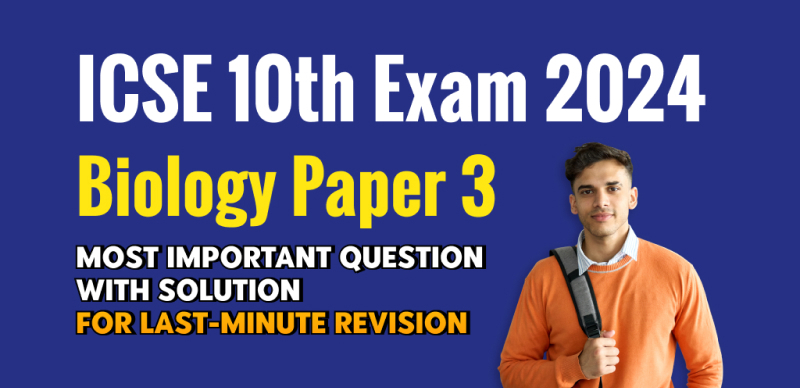
SHARING IS CARING
If our Website helped you a little, then kindly spread our voice using Social Networks. Spread our word to your readers, friends, teachers, students & all those close ones who deserve to know what you know now.
ICSE Class 10 exam is on 18th and you have very less time left for the Biology Paper 3 exam. Therefore, we are providing important multiple choice questions, short answer type questions and long answer type questions in this article. You can study them well and get good marks in your examination.
To help you prepare effectively, we have prepared a list of important questions with detailed explanations. This guide aims to make your exam preparation easier by providing information on these questions.
These questions cover various topics from the Biology Paper 3 syllabus. Remember, it is important to understand the logic behind each answer to score well.
ICSE Class 10th Biology Paper 3 Most Important Question
Important MCQ Question
1. New cells are to be produced for all the following processes except
(A) Movement
(B) Growth
(C) Reproduction
(D) Germination
Ans. (A) Movement
2. S phase represents
(A) synthesis
(B) gaps
(C) division
(D) resting
Ans. (A) synthesis
3. In which of the following parts of the chromosome, DNA does not exist in the form of nucleosomes?
(A) Euchromatin
(B) Kinetochore
(C) Heterochromatin
(D) Satellite DNA
Ans. (B) Kinetochore
4. Mendel chose pea plant for his experiment because
(A) They are bisexual
(B) They are in different varieties
(C) They are unisexual
(D) They are bisexual with many varietie
Ans. (D) They are bisexual with many varietie
5. The genes which are never passed from father to son is
(A) Holandric genes
(B) Y-linked genes
(C) X-linked genes
(D) XY linked
Ans. (C) X-linked genes
6. Sex linked inheritance is seen in
(A) Thalassemia and Haemophilia
(B) Hacmophilia and Sickle cell anaemia
(C) Haemophilia and Colour blindness
(D) All of these
Ans. (C) Haemophilia and Colour blindness
7. Diffusion of molecules are applicable to
(A) solids and liquids
(B) liquids and gases
(C) solids, liquids and gases
(D) liquids only
Ans. (C) solids, liquids and gases
8. In the soil, mostly the soil has
(A) more concentration of solute in solution
(B) more concentrated solution
(C) less concentrated solution
(D) isotonic solution
Ans. (C) less concentrated solution
9. Due to exosmosis of water
(A) guard cells become turgid
(B) guard cells become dead
(C) guard cells become flaccid
(D) no change in guard cells occurs
Ans. (C) guard cells become flaccid
10. Loss of water in the liquid droplet form occurs through
(A) transpiration
(B) guttation
(C) both transpiration and guttation
(D) bleeding
Ans. (B) guttation
11. Which of the following statements are true?
(A) In guard cells, turgor pressure increases during stomatal opening.
(B) Guard cells losses its chloroplasts during stomatal opening.
(C) In guard cells turgor pressure decreases during stomatal opening.
(D) Guard cells absorbs O₂ during photosynthesis
Ans. (A) In guard cells, turgor pressure increases during stomatal opening.
Read Also
12. Which of the following statements is true?
(A) Higher the temperature higher the rate of transpiration
(B) Higher the temperature lower the rate of transpiration
(C) Higher the temperature slower the evaporation of water molecules
(D) All the above
Ans. (A) Higher the temperature higher the rate of transpiration
13. When we plant more and more trees
(A) More oxygen is used up to clean the air
(B) More carbon dioxide is used up to clean the air
(C) More nitrogen is used up to clean the air
(D) More nitrogen is released
Ans. (B) More carbon dioxide is used up to clean the air
14. Minimum photosynthesis takes place in
(A) Violet part of the spectrum
(B) Blue part of the spectrum
(C) Red part of the spectrum
(D) Green part of the spectrum
Ans. (D) Green part of the spectrum
15. Which of the following is the first step of light reaction?
(A) Splitting of water molecules
(B) Excitation of chlorophyll molecules
(C) Intake of carbon dioxide
(D) Photophosphorylation
Ans. (B) Excitation of chlorophyll molecules
16. Ethylene is used for
(A) retarding ripening of tomatoes.
(B) hasten the ripening of fruits.
(C) slowing down ripening of apples.
(D) both (B) and (C).
Ans. (B) hasten the ripening of fruits.
17. Which one of the following is a natural growth inhibitor?
(A) NAA
(B) ABA
(C) IAA
(D) GA
Ans. (B) ABA
18. The growing leaves show
(A) geotropism
(B) hydrotropism
(C) phototropism
(D) thigmotropism
Ans. (C) phototropism
19. Platelets are well known as:
(A) leucocytes
(B) thrombocytes
(C) erythrocytes
(D) lymphatic fluid
Ans. (B) thrombocytes
20. Snake venom usually enters the body through an open wound and enters the bloodstream through the :
(A) Veins
(B) Lymphatic system
(C) Arteries
(D) None of these
Ans. (A) Veins
21. The artery that supplies blood to all parts of the body is called:
(A) pulmonary
(B) aorta
(C) pulmonary arch
(D) systematic arch
Ans. (B) aorta
22. Nitrogenous wastes excreted through urine in humans is
(A) Trimethylamine oxide
(B) Ammonia
(C) Uric Acid
(D) Urea
Ans. (D) Urea
23. A network of tiny blood vessels located at the beginning of a nephron is
(A) Renal calyces
(B) Renal pyramid
(C) Bowman's capsule
(D) Glomerulus
Ans. (D) Glomerulus
24. This pressure facilitates filtration while urine is being formed
(A) filtrate hydrostatic pressure
(B) osmotic blood pressure
(C) capillary hydrostatic pressure
(D) all of these
Ans. (A) filtrate hydrostatic pressure
25. Axon is enclosed in multilayered sheath called
(A) myelin sheath
(B) perikaryon
(C) dendrites
(D) unipolar neuron
Ans. (A) myelin sheath
26. Pons, cerebellum and medulla are part of which brain?
(A) Forebrain
(B) Midbrain
(C) Hindbrain
(D) None of these
Ans. (C) Hindbrain
27. It receives sound vibrations and passes to the ear drum.
(A) outer ear
(B) middle ear
(C) inner ear
(D) eustachian tube
Ans. (A) outer ear
28. This is not a function of insulin.
(A) decreasing glycogenolysis
(B) lipogenesis
(C) gluconeogenesis
(D) glycogenesis
Ans. (C) gluconeogenesis
29. Effects of hypothyroidism include all but this
(A) Diarrhoea
(B) Lethargy
(C) Anorexia
(D) Weight gain
Ans. (A) Diarrhoea
30. A gland having endocrine as well as exocrine function is
(A) Pituitary
(B) Thyroid
(C) Pancreas
(D) Adrenal
Ans. (C) Pancreas
31. Acrosome helps the sperm to
(A) Locate the ovum
(B) Swim to the ovum
(C) Penetrate the ovum
(D) None of these
Ans. (C) Penetrate the ovum
32. In human females, the fertilised egg gets implanted in the
(A) Uterus
(B) Vagina
(C) Ovary
(D) Ureter
Ans. (A) Uterus
33. In human females, an event that reflects onset of reproductive phase is
(A) growth of body
(B) changes in voice
(C) changes in hair pattern
(D) menstruation
Ans. (D) menstruation
34. Maximum number of individuals an environment can support is called
(A) Biotic potential
(B) Carrying capacity
(C) Birth rate
(D) Mortality rate
Ans. (B) Carrying capacity
35. The primary reason for increase in human population is
(A) The increase in agricultural production
(B) The increase in birth rate and decrease in death rate
(C) The improvement in medical technology
(D) All of these
Ans. (D) All of these
36. Humans belong to the family
(A) Hominidae
(B) Homo
(C) Primata
(D) Mammalia
Ans. (A) Hominidae
37. Select the mismatched pair.
(A) Dryopithecus-Walked like ape
(B) Homo habilis -Heavy eyebrow ridges
(C) Homo neanderthalensis- Small canines and herbivorous
(D) Homo erectus- Absence of chin
Ans. (C) Homo neanderthalensis- Small canines and herbivorous
38. The pollution which affects the aquatic life is
(A) Air pollution
(B) Water pollution
(C) Noise pollution
(D) Soil pollution
Ans. (B) Water pollution
39. Effects of pollution do not include
(A) Asthma
(B) Lung cancer
(C) Cough
(D) Malaria
Ans. (D) Malaria
40. Acid rain has a pH-
(A) lower than 5.6
(B) higher than 5.6
(C) lower than 11
(D) higher than 8.5
Ans. (A) lower than 5.6
Important Short Question Answer
1. (a) What is interphase?
(b) Mention three significant changes that occur in a cell during interphase.
Ans. (a) The period of cell cycle in which chromosomes replicates and cell prepares for division is called interphase.
(b) Interphase stage is considered as the preparatory stage for cell division. Main changes occurring in this
stage include -
• Synthesis of DNA
• Synthesis of RNA and protein
• Cell growth
2. (a) What is interphase?
(b) Mention three significant changes that occur in a cell during interphase.
Ans. (a) The period of cell cycle in which chromosomes replicates and cell prepares for division is called interphase.
(b) Interphase stage is considered as the preparatory stage for cell division. Main changes occurring in this
stage include -
• Synthesis of DNA
• Synthesis of RNA and protein
• Cell growth
3. Why did Mendel select garden pea for his experiments on genetics?
Ans. Mendel selected the garden pea for his experiments in genetics because:
(i) The plant has many varieties, showing a number of contrasting features.
(ii) The plants are easy to cultivate.
(iii) The plant is normally self-pollinating, so he could obtain pure strains.
(iv) Artificial cross-pollination resulted in fertile hybrids.
4. Give the reason:
(i) Gametes have a haploid number of chromosomes.
(ii) Mitosis differs in animal and plant cells.
Ans.(i) During mitosis cell division, the germ cells undergo two successive divisions producing four daughter cells each containing half number of chromosomes (n). Thus, in gametes, the chromosomes number is halved so that during fertilisation the normal diploid (2n) number can be restored.
(ii) During mitosis in animal cells, asters are formed and cytokinesis occur by furrowing. In plant cells, asters are not formed and cytokinesis occur by cell plate formation.
5. State Mendel's Law of Dominance.
Ans. Law of dominance: When a pair of contrasting characters present together, only one is able to express itself while the others remain suppressed. The character which is expressed, is dominant character and the character which is suppressed, is called recessive character.
6. What forces are involved in the absorption of water from the soil by root hair?
Ans. Transpiration pull of the aerial parts of the plants, cohesive forces between water molecules, adhesive forces between water and xylem vessels, and root pressure are the various forces involved in the absorption of water from the soil.
7. Explain two manifestations of root pressure.
Ans. The two manifestations of root pressure are :
(i) Exudation or Bleeding: Sometimes sap (water with dissolved inorganic and organic substances) exudes from the injured part of the plant. Exudation of milky latex from Calotropis is an example.
(ii) Guttation: When root pressure is high and transpiration is low, water drops ooze out through special structures called hydathodes. It can be seen in garden nasturtium.
8. What is the difference between a flaccid cell and a turgid cell?
Ans. Turgidity is a condition when a cell is fully stretched with water and all its walls are in a state of tension. e.g. when stomata is open. When a cell loses water from its cytoplasm and the plasma membrane is withdrawn, it is said to be flaccid, e.g., when stomata closes.
9. What are anti-transpirants? Name one anti-transpirant.
Ans. Anti-transpirants are chemical substances that reduce the rate of transpiration. They are generally used to improve the efficiency of water utilisation by plants, without affecting the carbon dioxide uptake. Example - Phenyl Mercuric Acetate (PMA).
10. Mention the significance of transpiration.
Ans. Significance of transpiration
(i) It helps in the absorption of water from the soil.
(ii) Produces cooling effect.
(iii) Maintains cell turgidity.
(iv) Controls opening and closing of stomata.
(v) Helps in absorption of minerals from the soil.
11. Green leaves are thin and broad. Give the reason.
Ans. Green leaves are thin and broad. The thinness of leaves allows the gases to diffuse in and out quickly. A large surface area of leaves allows the maximum absorption of light and thus, thin and broad feature of leaves allows higher rate of photosynthesis efficiently.
12. Most leaves have the upper surface more green and shiny. Why?
Ans. This is mainly due to chlorophyll. Chlorophyll is highly sensitive to light. The formation of chlorophyll itself depends on the exposure of the plant to light. As the upper surface of leaves get more sunlight than others, it looks more green and shiny.
13. Photosynthesis is considered as a process supporting all life on earth. Give the reason.
Ans. Photosynthesis is a vital process performed by green plants. It utilises the atmospheric CO2 and water to produce glucose and release oxygen. Thus, photosynthesis is necessary to maintain the life on earth.
14. Tips of the shoots move towards light. Explain.
Ans. Tips of the shoots move towards light. This is due to the directional movement towards the stimulus which is light, is known as positive phototropism. They bend towards the source of light.
15. The tendrils of a climber grows around the support. Give reason.
Ans. The tendrils of a climber grows around the support. It responds to the stimulus i.e. contact with a solid foreign body. Tendrils start off by bending in search of a surface to grow across, because of thigmotropism. Also, auxins synthesised at the tip of shoot stimulates faster on the opposite side causing tendrils to form a coil around the support.
16. Roots move towards soil in the ground. Explain.
Ans. Roots move towards the soil in the ground. This is due to positive geotropism. The roots of a plant move downwards in soil in direction of a stimulus i.e., gravity. Gravity provides the stimulus that causes the roots to grow towards the centre of the earth.
17. When does the heart produce the sounds 'LUBB' and 'DUBB' during heart beat?
Ans. The 'lubb' is the first sound associated with the closure of the tricuspid and biscuspid valves at the start of ventricular systole. On the other hand, the second sound 'dubb' is caused by the closure of semilunar valves at the opening of pulmonary artery and aorta, marking the end of systole.
18. Why is excretion necessary?
Ans. It is very essential that the waste substances are removed from the body and proper ionic balance within the body is maintained. If the waste substances are not removed, they may poison cells or may slow down metabolism.
19. Give the importance of osmoregulation.
Ans. Osmoregulation is the process of control of water content and concentration of ions in the body. Osmoregulation is very important as the blood plasma should be maintained at the right concentration. If the concentration of ions in the blood is higher than their concentration in the body cells, water will be drawn out from the body cells and the body cells in turn will shrink. If the blood has lower concentration, the body cells will absorb water from the blood and the body cells will enlarge in size.
20. How is presbyopia different from myopia?
Ans. Presbyopia: It is a condition affecting older people due to which they cannot see nearby objects clearly. Myopia : It is a condition in which the near objects can be seen clearly while the distant objects appear blurred, as the image is formed in front of the retina.
21. If you stand to make your maiden speech before a large audience, your mouth dries up and heart rate increases. What brings about these changes?
Ans. The hormone responsible for this is adrenaline. It is a hormone, which prepares the body to meet any emergency situation, for "Fight" i.e. to face danger or for "flight", i.e. to run away from it. Extra hormone is released into the blood at the time of emotional stress.
22. Do you agree with the statement - "All hormones are chemical signals"? Yes/No. Justify your answer.
Ans. Yes. Hormones are transmitted chemically through blood. They can bring about specific chemical changes and regulate metabolism. They activate each other and work in a coordinated manner. As for example, the hormone insulin acts on liver and muscle cells and deposit extra glucose in the form of glycogen.
23. What is death rate?
Ans. The number of deaths per thousand individuals in the population per year is called death rate. It is an important factor in controlling the size of a population.
24. Explain the role of insulin in maintaining blood sugar level.
Ans. The role of insulin in maintaining blood sugar level is that it lowers blood glucose level and induces protein synthesis. Insulin also initiates deposition of extra glucose in the liver and muscles as glycogen.
25. Define Euro standards.
Ans. Euro standards are the standards where all types of cars and commercial vehicles sold in Europe are subjected to strict limits on the emission of pollutants and on evaporative emissions from the fueling systems. Euro standards were introduced in 1991 with Euro 0 for passenger cars and in 1992 with Euro I for commercial vehicles.
Important Long Question Answer
1. Classify the types of chromosomes according to their shape.
Ans. Depending upon the position of centromere, a chromosome may have the following shapes-
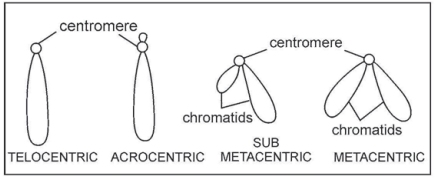
Telocentric: Rod shaped having centromere at the proximal end.
Acrocentric: Rod-shaped having centromere very close to one end but slightly below the normal position.
Submetacentric: T-shaped or L-shaped having centromere near the middle position.
Metacentric: 'V' shaped having the centromere at the centre and forming two equal arms.
2. Explain the following terms:
(1) Mutation
(ii) Homologous chromosomes
(iii) Alleles
Ans. (i) Mutation is a sudden change in certain characters or traits of an organism.
(ii) The chromosomes, having the same structural features and the same pattern of genes, are called homol- ogous chromosomes.
(iii) The two alternative forms of a gene are called alleles. Each gene consists of an allelomorphic pair.
3.(i) Explain the following terms:
1. Monohybrid cross.
2. Gene
3. Phenotype
(ii) Name the two sex-linked diseases in males.
Ans.(i) 1. Monohybrid cross :- A cross in which only one character is taken into consideration such as height, shape, colour, etc.
2. Gene: A gene is the unit of inheritance which is carried from the parent by a gamete in a chro- mosome and controls the expression of a character.
3. Phenotype: It is the physical expression of a trait (character), e.g. tall pea plant.
(ii) Colour blindness and haemophilia
4. Leaves of a sensitive plant wilt and droop down on a slight touch. What mechanism brings about this change?
Ans. Drooping of the leaflets of sensitive plant: If any leaf of Mimosa (Touch me-not plant) is touched, it will fold up and within 2-3 seconds the entire leaf droops. Slowly the leaf recovers. Stimulus of touch leads to loss of turgor pressure at the base of leaflets and base of petioles, causing the leaf to wilt temporarily.
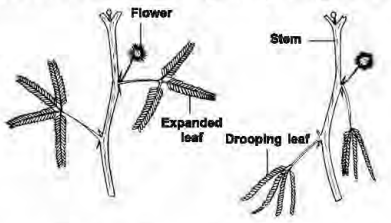
5. What is the difference between diffusion and osmosis? State the significance of osmosis in plant physiology.
Ans. Diffusion
1. It is the movement of any type of substances from the region of their higher concentration to that of lower concentration.
2. No membrane is required.
Osmosis
. It is the movement of water molecules from a solution of lower concentration to that of higher concentration across a semi-permeable membrane.
. It occurs through a semi-permeable membrane.
Significance of Osmosis: Osmosis is mainly responsible for the movement of water from non-living xylem elements into living cells. Osmosis depends on the stretched and rigid condition of cells which makes growth possible and is responsible for keeping the young stem erect and leaves extended.
6. State three ways in which roots are suited for absorbing water.
Ans. In land plants most of the water is absorbed through the roots. Roots are suited for absorbing water in the following ways:
(i) Surface area of roots : Roots are branched extensively, ending in millions of root tips. Numerous root hairs are present in the root hair zone of the root tip. Therefore, all together the roots of plants provide tremendous surface area which facilitates absorption of water.
(ii) Root hair contains cell sap of a concentration higher than that of the surrounding water. This characteristic is an important requirement to draw in the water from outside.
(iii) Root hairs have thin walls: Root hairs are an extension of the epidermal cell of the root. The cell wall is thin and allows the movement of water molecules and dissolved substances freely in and out. The cell membrane is thin but semi-permeable, i.e., it allows water molecules to pass through but not the larger molecules of the dissolved salts.
7. What is the significance of osmosis? Explain in brief.
Ans. Osmosis is the diffusion of water molecules only. It is defined as the net movement of water molecules from a region of higher concentration to a region of lower concentration through a semi-permeable membrane. It can be of two types i.e. endosmosis or exosmosis. Significance of osmosis: It helps in the absorption of water and minerals by the plants. It develops turgidity in cells and thus, maintains turgor pressure in them.
• It allows the movement of water from one cell to another thereby, ensuring flow of minerals too. It regulates the opening and closing of stomata.
• The soft organs such as leaves, flowers, fruits and young stems are able to keep themselves stretched and erect due to turgidity of their cell which is dependent upon osmosis.
8. List some adaptations found in desert plants to reduce transpiration.
Ans. Adaptations found in desert plants to reduce transpiration are:
(i) Leaves with thick cuticle - Some desert plants develop a thick waxy cuticle over the epidermis to reduce the loss of water by transpiration.
(ii) Reduced number of stomata - These plants have few stomata and concentrated on the underside of leaves to avoid direct sunlight.
(iii) Presence of epidermal hair - In some plants like cucurbits, leaf surface may be covered by thick coating of epidermal hairs to reduce transpiration.
(iv) Presence of sunken stomata- The stomata of leaves in dry environment sink into the leaf to reduce the surface area of the pores which further reduces rate of transpiration.
(v) Leaves modified into spines - In cactus, leaves are modified into spines to reduce surface area for transpiration, while their stem performs photosynthetic functions.
9. Mention four disadvantages of transpiration to the plant.
Ans. Four disadvantages of transpiration to the plant are:
(i) Stunted growth- Transpiration reduces the amount of water available to the plant. Plant with water deficit decreases in growth and thus, the plant remain stunted. Hence, excessive transpiration may result in the stunted growth of the plant.
(ii) Wilting-Wilting is the loss of turgidity. It occurs mostly during afternoon when transpiration rate is higher than the rate of water absorption through roots. The leaf cells become flaccid causing wilting of plant. Sometimes, it may be due to diseases also.
(iii) Energy expenditure-As most of the water absorbed is lost through transpiration, and energy is utilised in transpiration and conduction of water goes waste.
(iv) Abscission-When very little water is available to plant, transpiration results in the closing of stomata following the production of abscissic acid. It causes premature leaf fall and delayed flower production.
10. How does the rate of transpiration get affected by?
(a) Wind velocity
(b) Intensity of light
(c) Humidity
Ans. The rate of transpiration get affected by various internal and external factors. Some of the factors that affect it majorly are:
(a) Wind velocity- Wind will affect the rate of transpiration. Wind blow away the small pockets of humid air that develops when air is still. With the removal of these, wind will increase the movement of water from leaf surface, and thus more transpiration will occur. The higher the wind speed the higher the rate of transpiration.
(b) Intensity of light- The higher the light intensity, the higher the rate of evaporation. Light intensity stimulates stomatal openings which in turn brings about an increase in transpiration.
(c) Humidity-Humidity is defined as the water vapour present in the air. For water to evaporate, there must be a water potential gradient between the air in the leaf and the atmosphere. As the humidity increases in the surrounding, the rate of transpiration decreases. Water evaporates easily in drier air than that in more saturated air.
11. Given below is an experimental set-up. Study it and answer the questions given below.
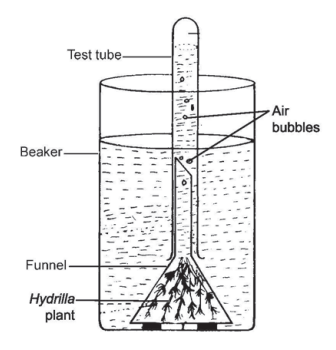
(a) What does the set-up show?
(b) Where should the set-up be kept?
(c) Name the gas that is bubbling out.
Ans.(a) It proves that oxygen is released during photosynthesis.
(b) The experiment should be set-up in light, preferably sunlight.
(c) Oxygen
12. With the help of an experiment, prove that roots are more positively hydrotropic than geotropic.
Ans. Take a piece of wire netting. Suspend it by means of wires. Place some moist sawdust around one inch on the wire netting and some germinating bean seeds are embedded in the sawdust. As the seeds germinate, the radicles initially grow downwards through the wire netting under the influence of gravity. But soon, they start growing upwards, towards the moist sawdust, which is the only source of water. In doing so, they grow against the force of gravity. The shoots grow upwards all the time.

This experiment shows that the roots grow downwards first and then towards water. It proves that for the roots, water is a more effective stimulus than gravity.
13. Given below is a diagram of the human heart. Observe it and answer the following questions—
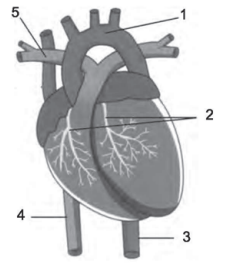
(a) Write the function of part 2.
(b) Differentiate between parts 3 and 4.
(c) Give a characteristic feature of part 5.
Ans. (a) Coronary arteries (2) arise from the base of aorta and they supply the blood to the heart muscles.
(b) Dorsal aorta (3) arise from the left ventricle and supply the blood to all the lower parts of the body. Inferior vena cava (4) carries deoxygenated blood from the lower half of the body including legs and abdomen to right atrium.
(c) Pulmonary artery (5) is the only artery which carries deoxygenated blood to the lungs from right ventricle for oxygenation in human body.
14. Explain the processes involved in the formation of urine.
Ans. The formation of urine requires three distinct processes
(a) Ultrafiltration: In the glomerulus mechanical filtration or ultrafiltration occurs. Water and small solutes are filtered while all solids and large molecules are retained.
The filtrate flowing through the tubule contains water, mineral salts, glucose, amino acids and nitrogenous waste products.
(b) Selective Reabsorption: In a normal adult, about 120 ml of filtrate is formed in the kidneys every minute. Thus, as the filtrate passes through the tubule, a selective reabsorption of useful materials occurs. This means that useful materials are taken back into the bloodstream. Most of the water is reabsorbed by osmosis. Some mineral salts and, in a normal individual, all the glucose and amino acids are reabsorbed through the walls of the tubule into the surrounding blood capillaries. This takes place by active transport (requires energy).
(c) Tubular secretion: This process is the reverse of tubular reabsorption. In this, the proximal convoluted tubule removes waste materials from the blood and pass these into the filtrate by the process of secretion. Uric acid, ammonia, urea, creatinine and some other molecules are removed by the process of tubular secretion.
15. Draw a diagram of the human eye as seen in a vertical section and label the part which suits the following
functions/descriptions:
(i) The layer which prevents reflection of light
(ii) The structure that helps to focus light on retina
(iii) The region of distinct vision
(iv) The part which transmits the impulse to the brain
(v) The outermost transparent layer in front of the eye lens
(vi) The fluid present in the anterior part of the eye in front of the eye lens
Ans.
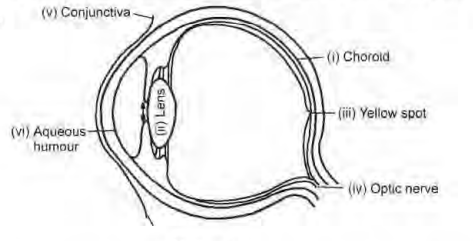
16. Draw a labelled diagram of a mature human sperm.
Ans.
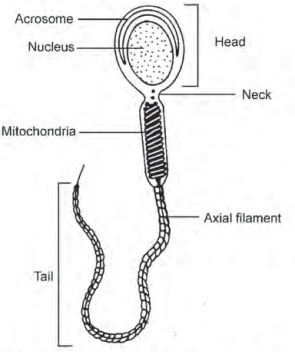
17. Given below are diagrams showing different stages in the process of fertilisation of an egg in the female reproductive tract:

(a) Use the alphabets given below each diagram to show the correct order in the process of fertilisation.
(b) Where in the female reproductive system does this process normally take place?
(c) What is the biological term for the product of fusion?
Ans. (a) The correct order in the process of fertilisation - D→ B → C→ A
(b) In fallopian tube
(c) Zygote
18. (i) What is meant by artificial insemination?
(ii) What are test-tube babies?
Ans.(i) Artificial insemination: When sperms of mature male are transferred to the female body by means other than the natural process. The procedure is called artificial insemination. This method is usually adopted to improve cattle breed. It involves collection of sperms of good quality bull, proper storage of sperms and their transfer into the vagina of a cow having desirable qualities.
(ii) Test-tube babies : In some women, normal conception is not possible. In such cases, ovum from the female and sperm from the male is collected and fertilisation is done in a test tube under controlled con- ditions. When the zygote reaches the 32-cell stage, it is implanted inside the uterus of the mother, where the foetus grows to full term.
19. Why has it not been possible to appreciably check the growth of population in our country so far?
Ans. Several factors are responsible for it:
(i) Lack of education
(ii) Traditional beliefs; considering birth of a child as a gift of god
(iii) Desire of a son
(iv) Economic reasons; more the children, more are the earning hands
(v) Reduction in mortality rate due to better medical facilities and public health care
20. How can the knowledge of processess of reproduction help people in limiting the size of their families? Give two concrete examples.
Ans. Knowledge of the processes of reproduction can help people in limiting the size of their families -
(i) Knowing the process of ovulation can help people to understand how some birth control pills work. This will remove their fears regarding such contraceptions.
(ii) Knowledge of the physiology of reproduction can help people undergo vasectomy and tubectomy without
any apprehension - This will help them in limiting the size of their families.
21. Mention three reasons why the growth of population has not been appreciably checked in India.
Ans. The growth of population has not been appreciably checked in India because of such reasons:
• Lack of education of illiteracy: Most population in India belongs to rural areas and are illiterate. They cannot think the consequences of having a large family and even do not want to discuss topics related to this.
• Mortality rate: Infant mortality rate is still higher in village areas due to illiteracy and inadequate medical facilities.
• Desire to have male child - Most Indians believe that only son can look after them in their old age and lineage is continued by him only.
22. What is Darwin's theory of evolution and how does it explain the diversity of life on Earth?
Ans. Darwin's theory of evolution proposes that all living organisms on Earth are related through a common ancestor and have evolved over time through the process of natural selection. Natural selection is the process by which individuals with favorable traits are more likely to survive and reproduce, passing those traits on to their offspring. Over time, this can lead to the emergence of new species and the diversity of life we see today.
23. (i) What is Lamarck's theory of evolution and how does it differ from Darwin's theory?
(ii) What were some of the key observations and conclusions that Lamarck made to support his theory of evolution?
Ans.(i) Lamarck's theory of evolution proposes that organisms can acquire traits during their lifetime that can be passed on to their offspring. In contrast, Darwin's theory of evolution proposes that traits are inherited through natural selection, and that individuals with advantageous traits are more likely to survive and reproduce.
(ii) Lamarck observed that organisms have an innate drive to adapt to their environment, and that this drive can result in the acquisition of new traits over the course of an individual's lifetime. He also observed that these acquired traits can be passed on to offspring, leading to evolutionary change over time.
24. Acid rain is a form of precipitation containing acidic components. State any three harmful impacts of acid rain.
Ans. (i) Impact on buildings and monuments: Acid rain is corrosive. It has a corroding effect on buildings, monuments, other metals and rock structures.
(ii) Impact on human health: Acid rain is related to several human hazards. There is irritation in eyes and skin, reduced visibility and disorders in respiratory system. Respiratory disorders include pulmonary emphysema and bronchitis.
(iii) Impact on wildlife: Several direct and indirect effects of acid rain on wildlife can be recognised. Acidic build-up in lakes disrupts the reproductive processes of some aquatic animals.
25. Is there any control measures to stop acid rain?
Ans. Yes, there are many control measures to stop acid rain. Some of those are :-
(i) The first and foremost measure to control acid rain is control over pollution, mainly air pollution.
(ii) Several emission-reducing equipments such as scrubbers, electrostatic precipitators, etc, can be used for reducing air pollutants.
(iii) The practice of adding a neutralising agent to the acidified water to increase the pH is one of the important control measures.
(iv) Controlling acid rain requires local, governmental and international participation.







 Profile
Profile Signout
Signout












 Quiz
Quiz
 Get latest Exam Updates
Get latest Exam Updates 










